for i = 1:length(EbN0db)
fprintf('%10.2f',EbN0db(i));
end
fprintf('\n----------------------------------------------------\n\n');
fprintf('+ + + + Please be patient. Wait a while to get the result. + + + +\n\n');
for nEN = 1:length(EbN0db)
en = 10^(EbN0db(nEN)/10);
% convert Eb/N0 from unit db to normal numbers
L_c = 4*a*en*rate;
% reliability value of the channel
sigma = 1/sqrt(2*rate*en);
% standard deviation of AWGN noise
% Clear bit error counter and frame error counter
errs(nEN,1:niter) = zeros(1,niter);
nferr(nEN,1:niter) = zeros(1,niter);
nframe = 0;
% clear counter of transmitted frames
while nferr(nEN, niter)
else
L_all = sova(rec_s(2,:), g, L_a, 2);
% complete info.
end
L_e = L_all - 2*rec_s(2,1:2:2*L_total) - L_a;
% extrinsic info.
% Estimate the info. bits
xhat(alpha) = (sign(L_all)+1)/2;
% Number of bit errors in current iteration
err(iter) = length(find(xhat(1:L_total-m)~=x));
% Count frame errors for the current iteration
if err(iter)>0
nferr(nEN,iter) = nferr(nEN,iter)+1;
end
end
%iter
% Total number of bit errors for all iterations
errs(nEN,1:niter) = errs(nEN,1:niter) + err(1:niter);
if rem(nframe,3)==0 | nferr(nEN, niter)==ferrlim
% Bit error rate
ber(nEN,1:niter) = errs(nEN,1:niter)/nframe/(L_total-m);
% Frame error rate
fer(nEN,1:niter) = nferr(nEN,1:niter)/nframe;
% Display intermediate results in process
fprintf('******************* Eb/N0 = %5.2f db ********************\n', EbN0db(nEN));
fprintf('Frame size = %d, rate 1/%d. \n', L_total, 2+puncture);
fprintf('%d frames transmitted, %d frames in error.\n', nframe, nferr(nEN, niter));
fprintf('Bit Error Rate (from iteration 1 to iteration %d):\n', niter);
for i=1:niter
fprintf('%8.4e
', ber(nEN,i));
end
fprintf('\n');
fprintf('Frame Error Rate (from iteration 1 to iteration %d):\n', niter);
for i=1:niter
fprintf('%8.4e
', fer(nEN,i));
end
fprintf('\n');
fprintf('*********************************************************\n\n');
% Save intermediate results
save turbo_sys_demo EbN0db ber fer
end
end
end
%while
%nEN
diary off
4
�
%------------------------------------------------------------------------------------------------
function [output, state] = encode_bit(g, input, state)
% This function takes as an input a single bit to be encoded, as well as
% the coeficients of the generator polynomials and the current state vector.
% It returns as output n encoded data bits, where 1/n is the code rate.
% the rate is 1/n k is the constraint length m is the amount of memory
[n,k] = size(g);
%g
m = k-1;
%
% determine the next output bit
for i=1:n
output(i) = g(i,1)*input;
% the first bit a_k's contribution to output
for j = 2:k
output(i) = xor(output(i),g(i,j)*state(j-1)); % a_(k-j)'s contribution to output
end;
end
state = [input, state(1:m-1)]; % shift one bit
%------------------------------------------------------------------------------------------------
function y = rsc_encode(g, x, terminated)
% encodes a block of data x (0/1)with a recursive systematic convolutional code
% with generator vectors in g, and returns the output in y (0/1).
% if terminated>0, the trellis is perfectly terminated
% if terminated<0, it is left unterminated;
% determine the constraint length (K), memory (m), and rate (1/n)and number of information bits.
[n,K] = size(g);
m = K - 1;
if terminated>0
L_info = length(x);
% L_info: lenght of information sequence
L_total = L_info + m; % L_total:m additional bits is used to terminate
else
L_total = length(x);
L_info = L_total - m; % see the sequence for untermated in function encoderm for reason. length of x is
L_total
end
state = zeros(1,m);
% initialize the state vector
% generate the codeword
for i = 1:L_total
if terminated<0 | (terminated>0 & i<=L_info)
d_k = x(1,i);
% d_k: information sequence
elseif terminated>0 & i>L_info
% terminate the trellis
d_k = rem( g(1,2:K)*state', 2 );
%
end
a_k = rem( g(1,:)*[d_k state]', 2 );
% a_k: the bit to be put into the register
5
�
[output_bits, state] = encode_bit(g, a_k, state);
output_bits(1,1) = d_k;
% since systematic, first output is input bit
y(n*(i-1)+1:n*i) = output_bits;
% n output bits for 1 input bit(recursiv encoder)
end
%------------------------------------------------------------------------------------------------
function en_output = encoderm( x, g, alpha, puncture )
% uses interleaver map 'alpha'
% if puncture = 1, unpunctured, produces a rate 1/3 output of fixed length
% if puncture = 0, punctured, produces a rate 1/2 output
% multiplexer chooses odd check bits from RSC1 and even check bits from RSC2
% determine the constraint length (K), memory (m)and number of information bits plus tail bits.
[n,K] = size(g);
m = K - 1;
L_info = length(x);
L_total = L_info + m;
% generate the codeword corresponding to the 1st RSC coder
% end = 1, perfectly terminated;
input = x;
output1 = rsc_encode(g,input,1);
% make a matrix with first row corresponing to info sequence
% second row corresponsing to RSC #1's check bits.
% third row corresponsing to RSC #2's check bits.
% y: unpuncture output of encoder; y(1,:) has m bits more than input bits
y(1,:) = output1(1:2:2*L_total);
y(2,:) = output1(2:2:2*L_total);
% interleave input to second encoder
for i = 1:L_total
input1(1,i) = y(1,alpha(i));
%alpha--index of interleaver
end
%input has been interleaved. L_total bits already.end =-1unterminated
output2 = rsc_encode(g, input1(1,1:L_total), -1 );
y(3,:) = output2(2:2:2*L_total);
% paralell to serial multiplex to get output vector
% puncture = 0: rate increase from 1/3 to 1/2;
% puncture = 1unpunctured, rate = 1/3;
if puncture > 0
% unpunctured
for i = 1:L_total
for j = 1:3
6
�
en_output(1,3*(i-1)+j) = y(j,i); % put the 3 bits of the same colomn to a sequential outputs
end
end
else
for i=1:L_total
% punctured into rate 1/2
en_output(1,n*(i-1)+1) = y(1,i);
if rem(i,2)
% output check bits by turns
en_output(1,n*i) = y(2,i);
% odd check bits from RSC1
else
en_output(1,n*i) = y(3,i);
% even check bits from RSC2
end
end
end
% antipodal modulation: +1/-1
en_output = 2 * en_output - ones(size(en_output));
%------------------------------------------------------------------------------------------------
function int_state = int_state( state )
% converts a row vector of m bits into a integer (base 10)
[dummy, m] = size( state );
for i = 1:m
vect(i) = 2^(m-i);
end
int_state = state*vect';
%------------------------------------------------------------------------------------------------
function bin_state = bin_state( int_state, m )
% converts an vector of integer into a matrix; the i-th row is the binary form
% of m bits for the i-th integer
for j = 1:length( int_state )
% length(int_state)?=max_state? --yzh
for i = m:-1:1
state(j,m-i+1) = fix( int_state(j)/ (2^(i-1)) );
% fix(X) rounds the elements of X to the nearest
integers towards zero.
int_state(j) = int_state(j) - state(j,m-i+1)*2^(i-1);
% remain of mod 2^(i-1), the leftmost bit
is most significant -yzh
end
end
bin_state = state;
%------------------------------------------------------------------------------------------------
function subr = demultiplex(r, alpha, puncture);
% At receiver end, serial to paralle demultiplex to get the code word of each encoder
7
�
% alpha: interleaver mapping
% puncture = 0: use puncturing to increase rate to 1/2;
% puncture = 1; unpunctured, rate 1/3;
% Frame size, which includes info. bits and tail bits
L_total = length(r)/(2+puncture);
% Extract the parity bits for both decoders
if puncture == 1
% unpunctured
for i = 1:L_total
x_sys(i) = r(3*(i-1)+1);
for j = 1:2
subr(j,2*i) = r(3*(i-1)+1+j); % 1/3 rate, one info.bit, two parity bits
end
end
else
for i = 1:L_total
% punctured, 1/2 rate
x_sys(i) = r(2*(i-1)+1); % odd posisition is systematic bits,
for j = 1:2
subr(j,2*i) = 0;
end
if rem(i,2)>0
% even position,one check bit from ENC1, one from ENC2 alternatively
subr(1,2*i) = r(2*i); % puntured parity bits are padded to zero
else
subr(2,2*i) = r(2*i);
end
end
end
% Extract the systematic bits for both decoders
for j = 1:L_total
% For decoder one
subr(1,2*(j-1)+1) = x_sys(j);
% odd positions is reserved for systematic bits
% For decoder two: interleave the systematic bits
subr(2,2*(j-1)+1) = x_sys(alpha(j)); % info.bits that are put into DEC2 are interleaved bits -yzh
end
%------------------------------------------------------------------------------------------------
function [next_out, next_state, last_out, last_state] = trellis(g)
% set up the trellis given code generator g
% g given in binary matrix form. e.g. g = [ 1 1 1; 1 0 1 ];
% next_out(i,1:2): trellis next_out (systematic bit; parity bit) when input = 0, state = i; next_out(i,j)
= -1 or 1
% next_out(i,3:4): trellis next_out
(systematic bit; parity bit) when input = 1, state = i;
% next_state(i,1): next state when input = 0, state = i; next_state(i,i) = 1,...2^m
% next_state(i,2): next state when input = 1, state = i;
% last_out(i,1:2): trellis last_out (systematic bit; parity bit) when input = 0, state = i; last_out(i,j)
8
�
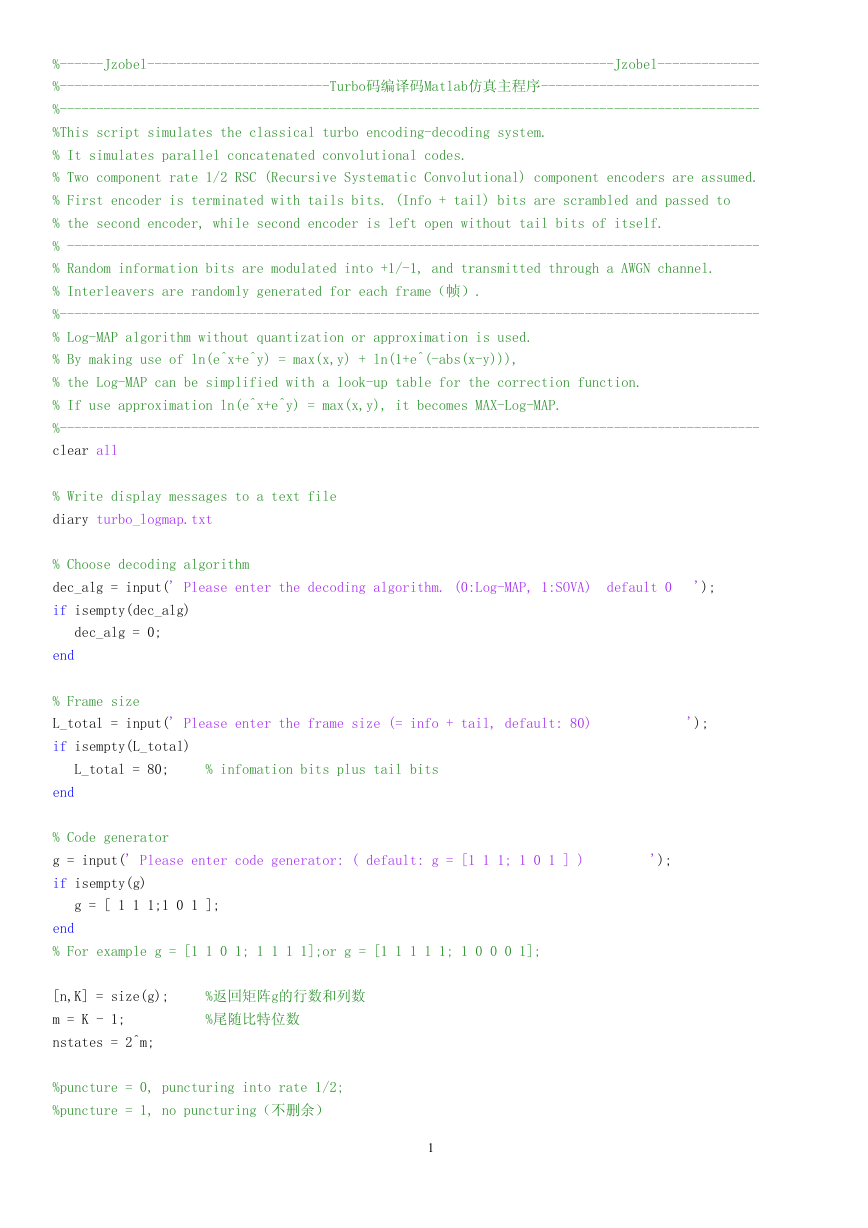
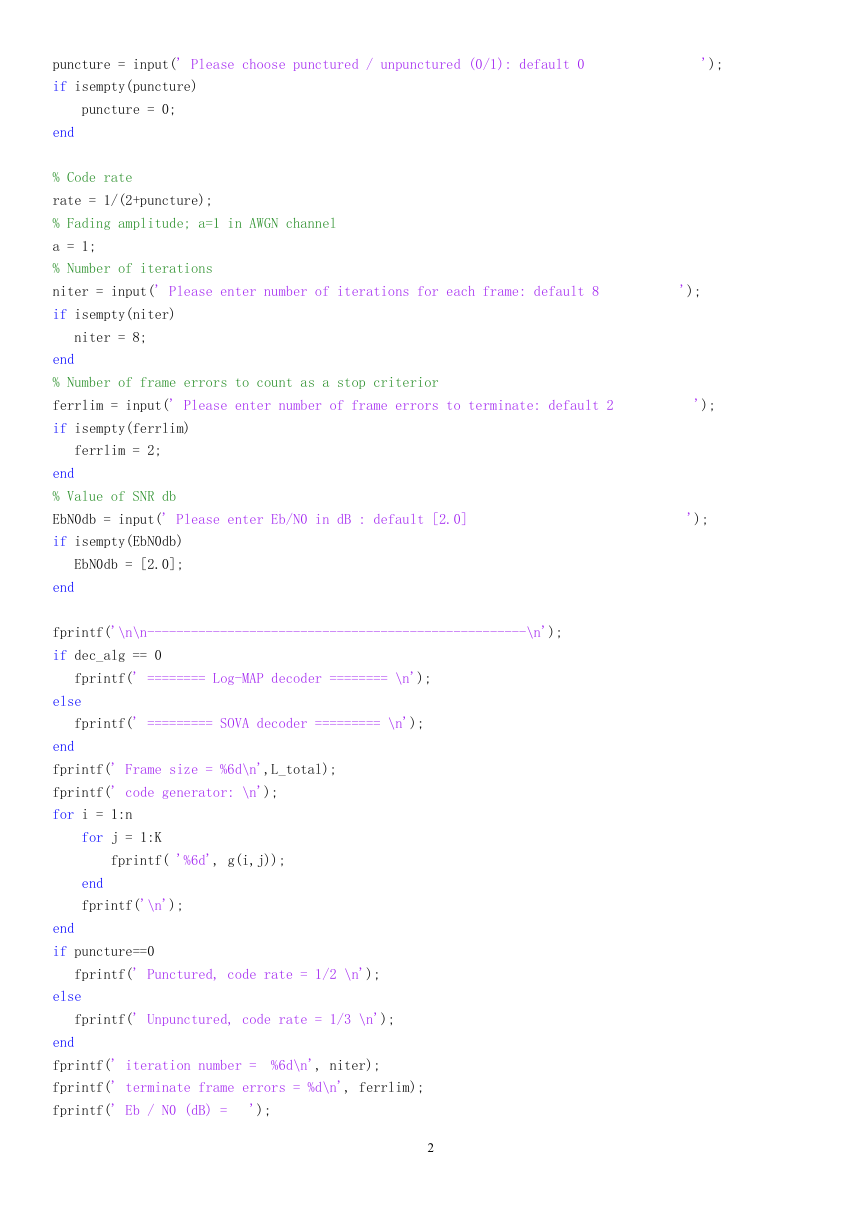
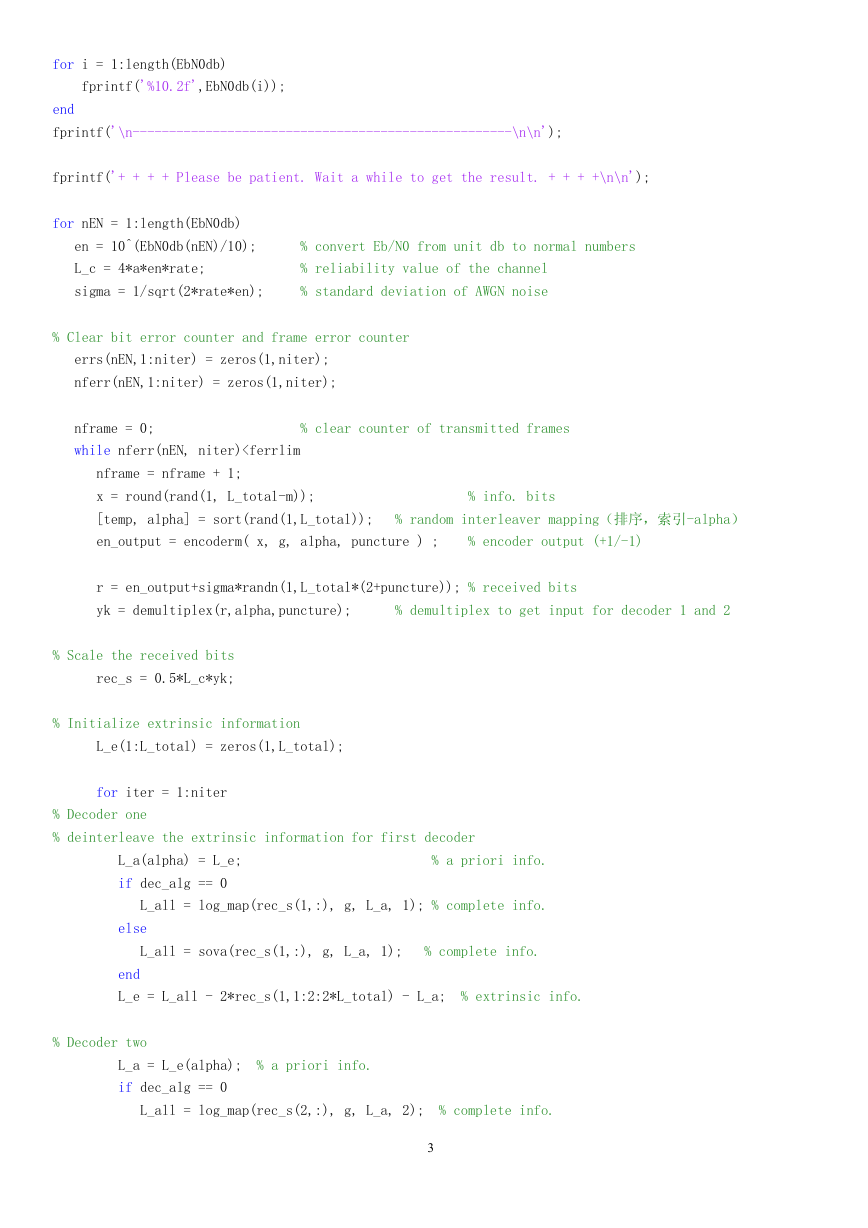
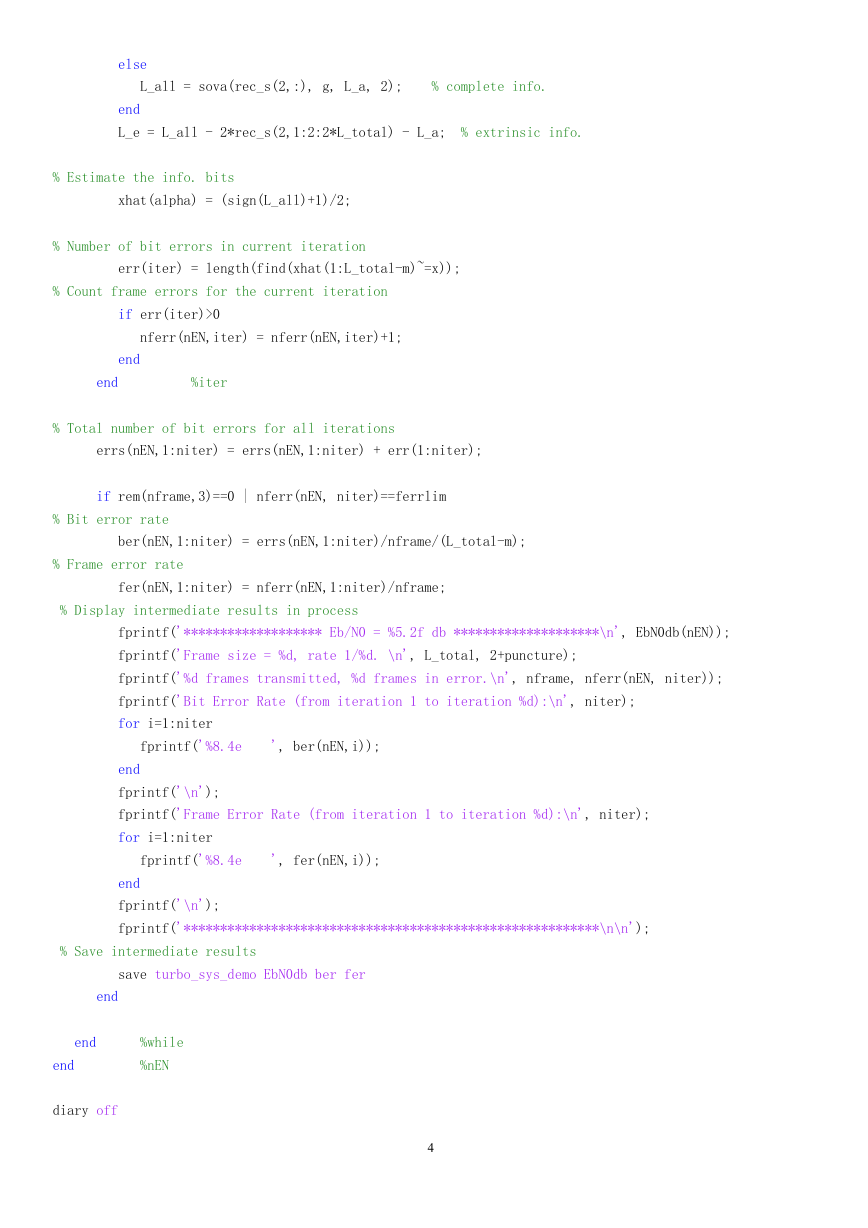
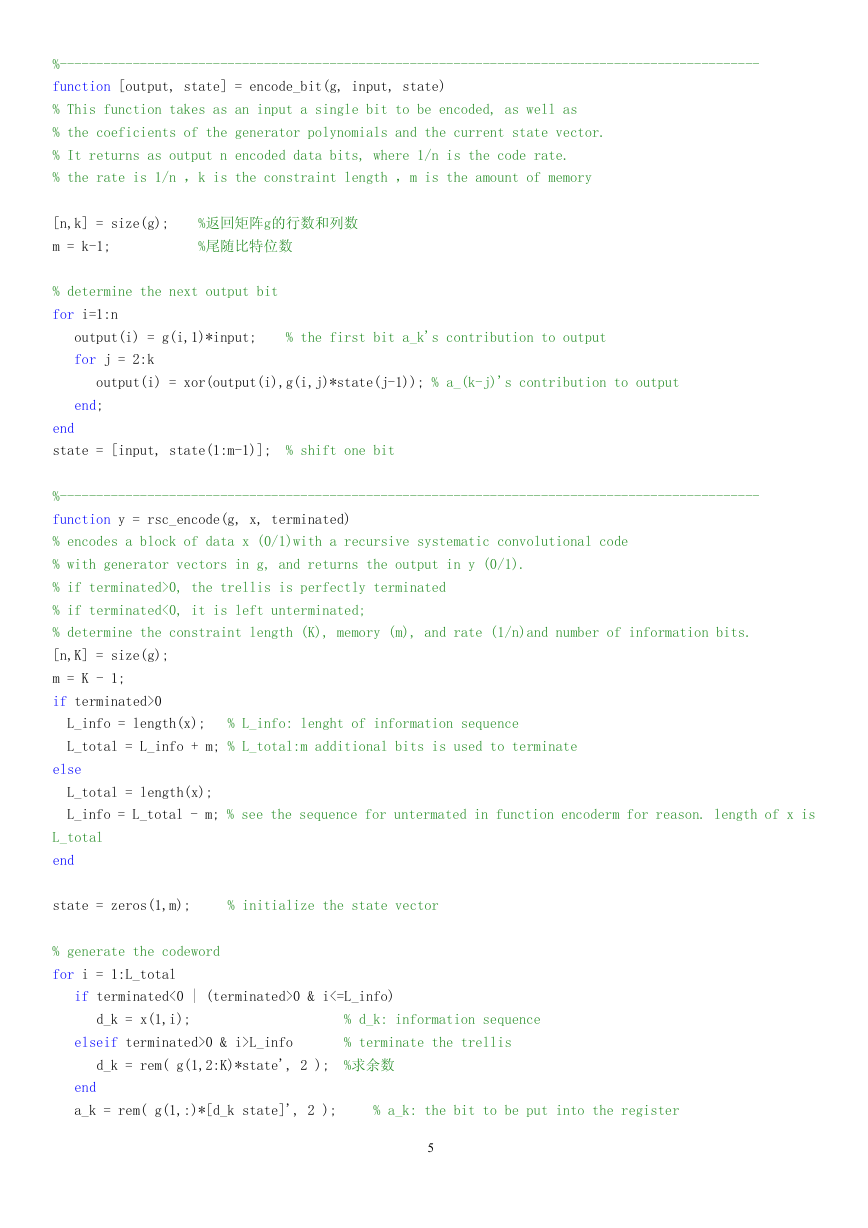
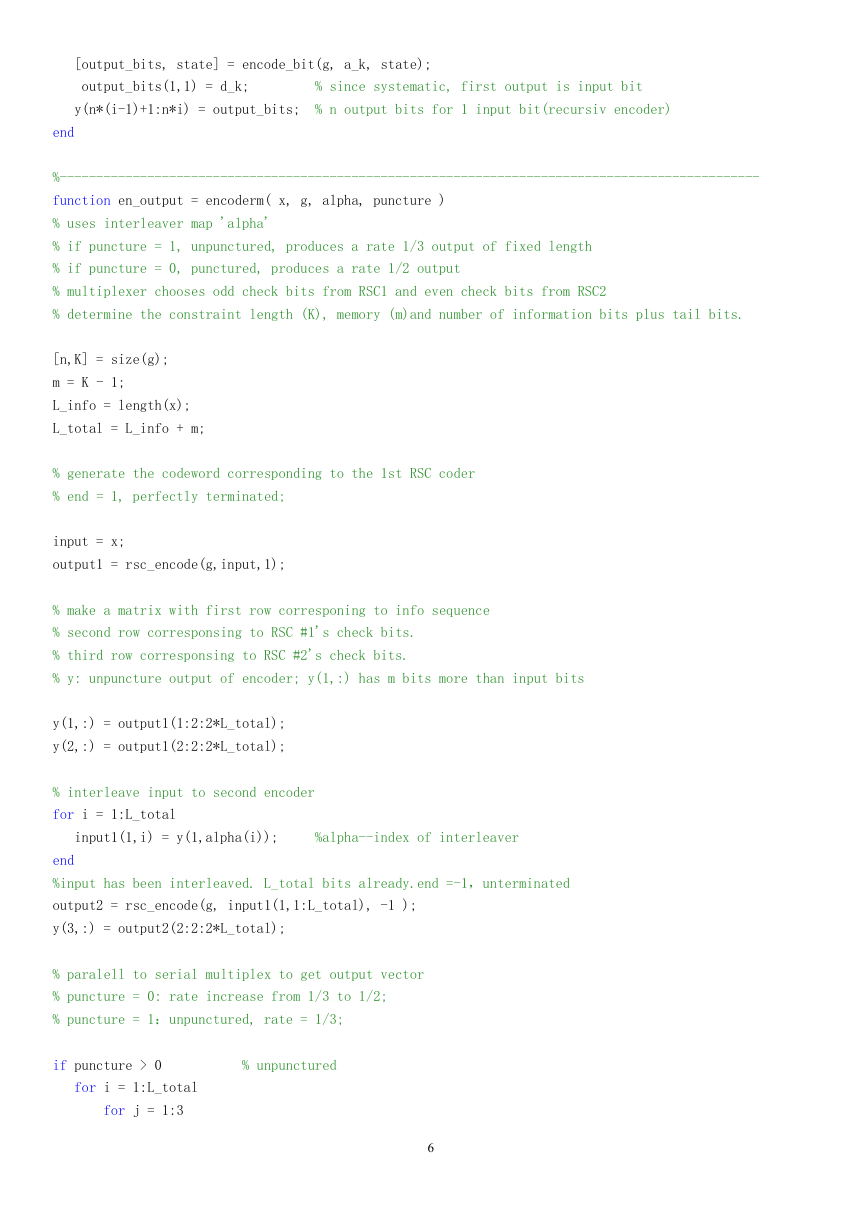
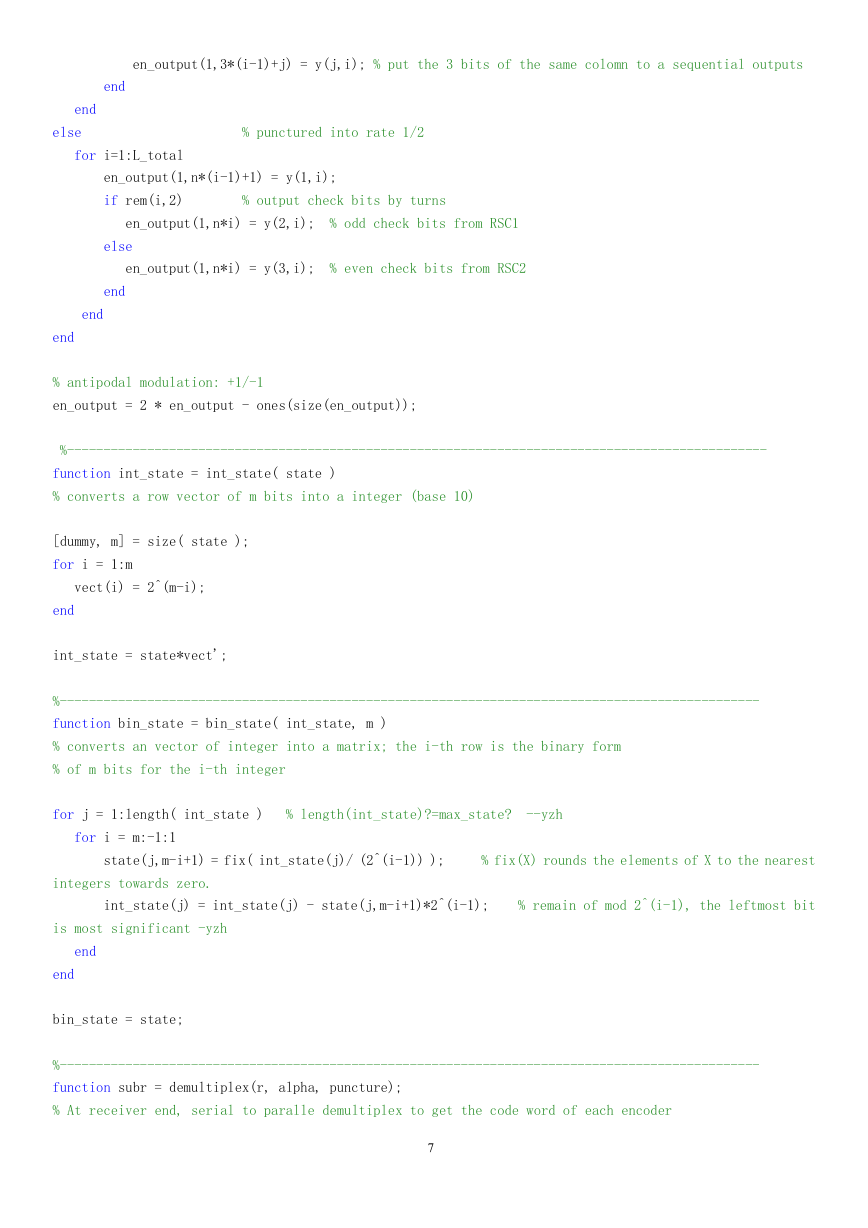
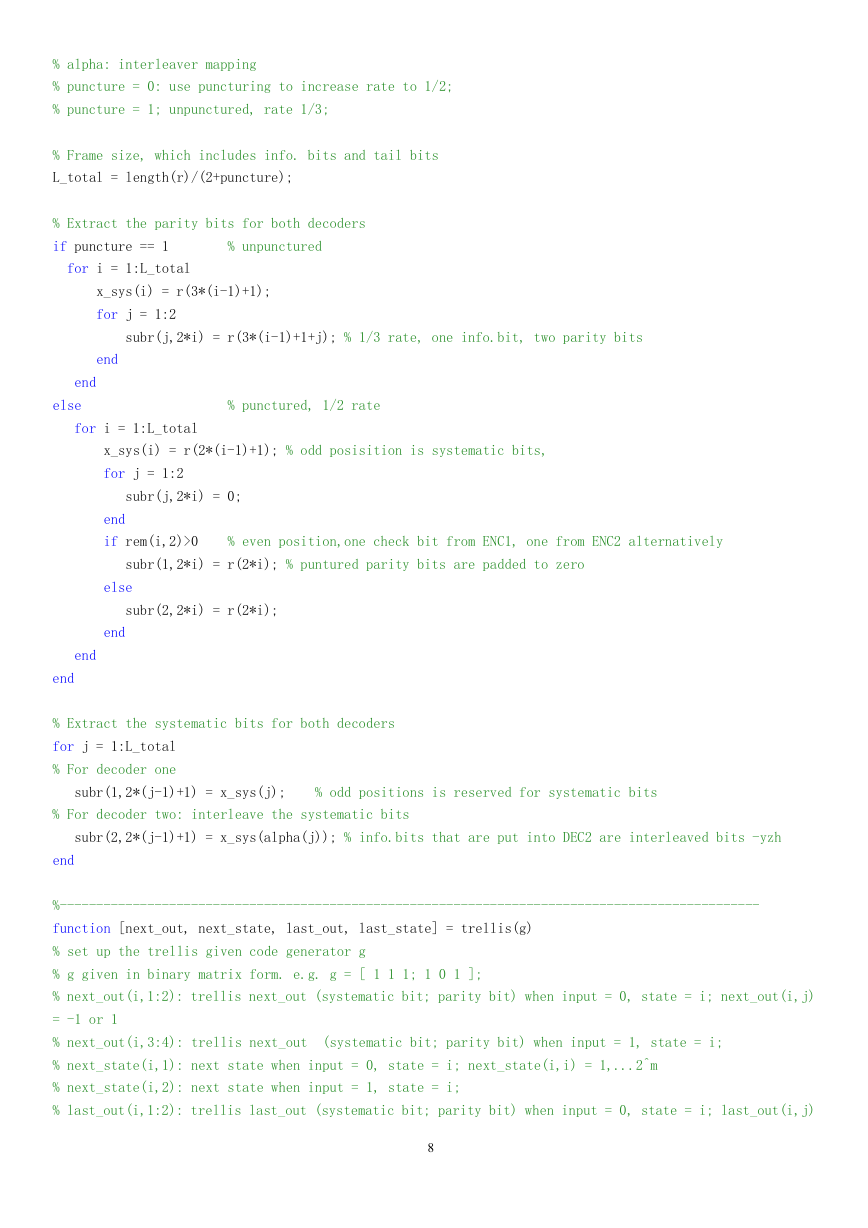








 2023年江西萍乡中考道德与法治真题及答案.doc
2023年江西萍乡中考道德与法治真题及答案.doc 2012年重庆南川中考生物真题及答案.doc
2012年重庆南川中考生物真题及答案.doc 2013年江西师范大学地理学综合及文艺理论基础考研真题.doc
2013年江西师范大学地理学综合及文艺理论基础考研真题.doc 2020年四川甘孜小升初语文真题及答案I卷.doc
2020年四川甘孜小升初语文真题及答案I卷.doc 2020年注册岩土工程师专业基础考试真题及答案.doc
2020年注册岩土工程师专业基础考试真题及答案.doc 2023-2024学年福建省厦门市九年级上学期数学月考试题及答案.doc
2023-2024学年福建省厦门市九年级上学期数学月考试题及答案.doc 2021-2022学年辽宁省沈阳市大东区九年级上学期语文期末试题及答案.doc
2021-2022学年辽宁省沈阳市大东区九年级上学期语文期末试题及答案.doc 2022-2023学年北京东城区初三第一学期物理期末试卷及答案.doc
2022-2023学年北京东城区初三第一学期物理期末试卷及答案.doc 2018上半年江西教师资格初中地理学科知识与教学能力真题及答案.doc
2018上半年江西教师资格初中地理学科知识与教学能力真题及答案.doc 2012年河北国家公务员申论考试真题及答案-省级.doc
2012年河北国家公务员申论考试真题及答案-省级.doc 2020-2021学年江苏省扬州市江都区邵樊片九年级上学期数学第一次质量检测试题及答案.doc
2020-2021学年江苏省扬州市江都区邵樊片九年级上学期数学第一次质量检测试题及答案.doc 2022下半年黑龙江教师资格证中学综合素质真题及答案.doc
2022下半年黑龙江教师资格证中学综合素质真题及答案.doc